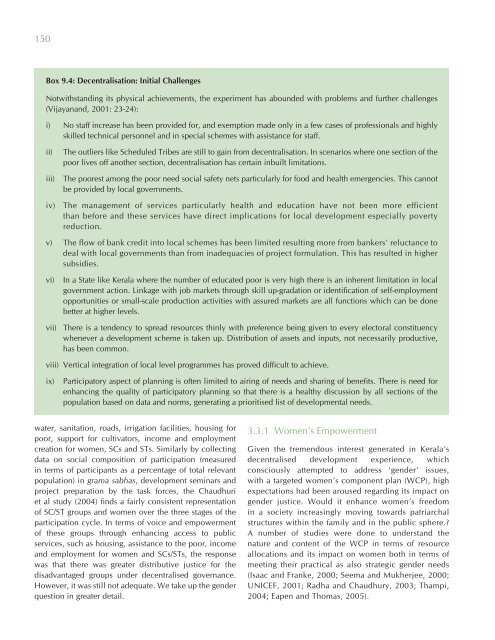Kerala 2005 - of Planning Commission
Kerala 2005 - of Planning Commission
Kerala 2005 - of Planning Commission
You also want an ePaper? Increase the reach of your titles
YUMPU automatically turns print PDFs into web optimized ePapers that Google loves.
150<br />
Box 9.4: Decentralisation: Initial Challenges<br />
Notwithstanding its physical achievements, the experiment has abounded with problems and further challenges<br />
(Vijayanand, 2001: 23-24):<br />
i) No staff increase has been provided for, and exemption made only in a few cases <strong>of</strong> pr<strong>of</strong>essionals and highly<br />
skilled technical personnel and in special schemes with assistance for staff.<br />
ii)<br />
The outliers like Scheduled Tribes are still to gain from decentralisation. In scenarios where one section <strong>of</strong> the<br />
poor lives <strong>of</strong>f another section, decentralisation has certain inbuilt limitations.<br />
iii) The poorest among the poor need social safety nets particularly for food and health emergencies. This cannot<br />
be provided by local governments.<br />
iv) The management <strong>of</strong> services particularly health and education have not been more efficient<br />
than before and these services have direct implications for local development especially poverty<br />
reduction.<br />
v) The flow <strong>of</strong> bank credit into local schemes has been limited resulting more from bankers’ reluctance to<br />
deal with local governments than from inadequacies <strong>of</strong> project formulation. This has resulted in higher<br />
subsidies.<br />
vi)<br />
In a State like <strong>Kerala</strong> where the number <strong>of</strong> educated poor is very high there is an inherent limitation in local<br />
government action. Linkage with job markets through skill up-gradation or identification <strong>of</strong> self-employment<br />
opportunities or small-scale production activities with assured markets are all functions which can be done<br />
better at higher levels.<br />
vii) There is a tendency to spread resources thinly with preference being given to every electoral constituency<br />
whenever a development scheme is taken up. Distribution <strong>of</strong> assets and inputs, not necessarily productive,<br />
has been common.<br />
viii) Vertical integration <strong>of</strong> local level programmes has proved difficult to achieve.<br />
ix)<br />
Participatory aspect <strong>of</strong> planning is <strong>of</strong>ten limited to airing <strong>of</strong> needs and sharing <strong>of</strong> benefits. There is need for<br />
enhancing the quality <strong>of</strong> participatory planning so that there is a healthy discussion by all sections <strong>of</strong> the<br />
population based on data and norms, generating a prioritised list <strong>of</strong> developmental needs.<br />
water, sanitation, roads, irrigation facilities, housing for<br />
poor, support for cultivators, income and employment<br />
creation for women, SCs and STs. Similarly by collecting<br />
data on social composition <strong>of</strong> participation (measured<br />
in terms <strong>of</strong> participants as a percentage <strong>of</strong> total relevant<br />
population) in grama sabhas, development seminars and<br />
project preparation by the task forces, the Chaudhuri<br />
et al study (2004) finds a fairly consistent representation<br />
<strong>of</strong> SC/ST groups and women over the three stages <strong>of</strong> the<br />
participation cycle. In terms <strong>of</strong> voice and empowerment<br />
<strong>of</strong> these groups through enhancing access to public<br />
services, such as housing, assistance to the poor, income<br />
and employment for women and SCs/STs, the response<br />
was that there was greater distributive justice for the<br />
disadvantaged groups under decentralised governance.<br />
However, it was still not adequate. We take up the gender<br />
question in greater detail.<br />
3.3.1 Women’s Empowerment<br />
Given the tremendous interest generated in <strong>Kerala</strong>’s<br />
decentralised development experience, which<br />
consciously attempted to address ‘gender’ issues,<br />
with a targeted women’s component plan (WCP), high<br />
expectations had been aroused regarding its impact on<br />
gender justice. Would it enhance women’s freedom<br />
in a society increasingly moving towards patriarchal<br />
structures within the family and in the public sphere.?<br />
A number <strong>of</strong> studies were done to understand the<br />
nature and content <strong>of</strong> the WCP in terms <strong>of</strong> resource<br />
allocations and its impact on women both in terms <strong>of</strong><br />
meeting their practical as also strategic gender needs<br />
(Isaac and Franke, 2000; Seema and Mukherjee, 2000;<br />
UNICEF, 2001; Radha and Chaudhury, 2003; Thampi,<br />
2004; Eapen and Thomas, <strong>2005</strong>).

















